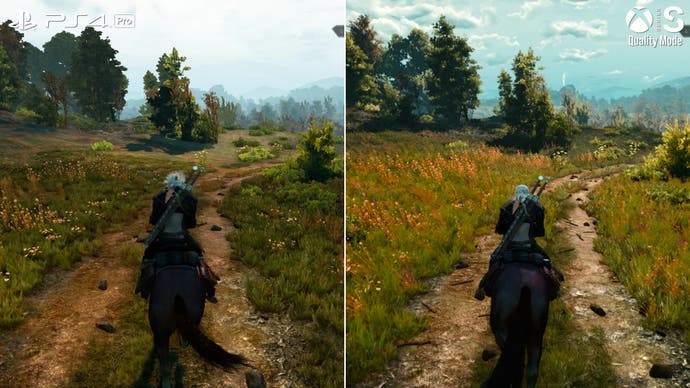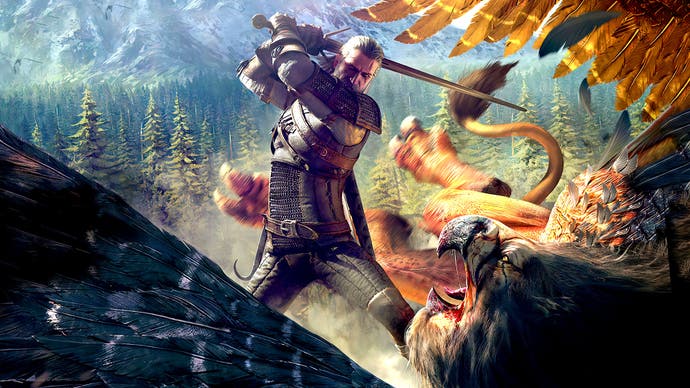Can Xbox Series S still deliver a next-gen Witcher 3 experience?
Ray tracing is gone, but the package still impresses overall.
Following our look at the PS5 and Series X versions of The Witcher 3 Complete Edition, we're completing our coverage for this year by taking a look at the one version of the game we've yet to cover: Xbox Series S. Expectations need to be tempered, obviously, as we're looking at a four-teraflop GPU at the heart of the console in a world where even the 12TF Series X rendition didn't run flawlessly, so the omission of the ray tracing mode on Series S is hardly a surprise. The upside? Series S still offers a 60 frames per second performance mode and also a higher resolution 30fps 'quality' alternative - so how do they run?
Obviously the resolution targets for each differ: on performance mode we're looking at a native 1080p target, and on its quality mode, CD Projekt RED targets 1440p. Dynamic scaling is possible, but in Series S' case it's honestly been rare in testing; so often each mode hits its resolution targets. While we're comparing the two modes there's a few other differences to note above pixel count and frame-rate differences. Firstly, to hit 60fps on the performance mode, the foliage draw distance is dropped back a preset, in essence, meaning more pop-in closer to the screen on Series S at 60fps, while quality mode draws in more plant life to the far distance.
Otherwise, every other setting appears matched between the two modes. Reflection quality, textures and even world shadows are all exactly the same. In my experience, the drop to 1080p and the lower foliage draw setting really are the biggest sacrifices to hitting 60fps. Even so, 60fps is the way to go for this one, even with its blurrier image. The main reason being that just like PS5 and Series X, Series S suffers from noticeable input latency problems on its 30fps quality mode. I recorded a response time of 157ms on PS5 in its RT mode - or 145ms subtracting my TV's own latency - and Series S has a similar level of latency for every input you make. The fact is that camera movement is noticeably delayed, and the boosted res and settings just aren't worth that trade-off.
Looking at Series S more closely in relation to Series X, the obvious loss is the lack of ray-traced ambient occlusion and global illumination. Interiors lack realistic shading, and light bounce isn't as accurate. It's a stark difference indoors, with Series S' shading of materials appearing flatter, though in fairness to Series S, outdoors areas in broad daylight are reasonably comparable. Even the resolution isn't hugely different between them, since both sides run at a native 1440p for the most part.
One of the bigger losses on Series S - a feature that I'd hoped we might still see despite the dropped RT features - is the updated screen-space reflection technique. Alas, the new SSR is also completely missing on Series S, defaulting us back to the more basic last-gen method. It looks fine but we miss the puddle reflections and the reflections on armour that work so well on the PS5 and Series X RT modes. As an aside, Series S' quality mode actually runs with a higher foliage draw setting than our Series X run - putting it on par to PS5. But honestly, I suspect this is a bug with Series X that will soon be fixed.
Speaking of last-gen, the older PS4 Pro version is perhaps a more realistic comparison point. After all, PS4 Pro's not far off in terms of the raw on-paper power spec - 4.2TF up against Series S 4TF. Obviously, there's a huge difference in architecture between them - not least a higher clocked Zen 2 CPU - that affords Series S a critical edge in visual settings. Stacking up Pro's 30fps output with Series S' quality mode, draw distance is well ahead. That drops a setting if you switch to Series S' performance mode, but in either mode it's a huge upgrade over last-gen.

Equally, texture quality and models are all updated on Series S, in line with the other current-gen machines. Plus, shadow resolution is boosted across the world. The final point here is that the NPC count on Series S is also typically on par with PS5 and Series X, meaning areas like Novigrad are packed with bustling crowds, which PS4 Pro is missing.
Elsewhere, image quality differences are the only other thing to bear in mind. Series S renders at a native 1440p, while PS4 Pro targets 4K, reconstructing a 1920x2160 base image using checkerboard rendering. For my money, PS4 Pro does actually end up producing a sharper image. It's a more linear scale to 4K, but on balance the boosted foliage, higher-res textures, shadows and increased NPC count make Series S more presentable. It's a similar story with the older One X version - which targets 4K as well - and generally produces a crisper image than what we get on newer machines. But again, One X misses a huge list of other visual tweaks and upgrades.
Looking at performance, Series S impresses initially, hitting a rock-solid 30fps, no matter what I threw at the console and no matter which of the classic stress points I used. Even in the Heirarch Square, which is a real CPU stress-test for PS5 and Series X, there are zero issues. Series S has the same high NPC count as those much more powerful consoles, although without the ray-tracing features, and it's absolutely holding 30fps, unlike the two more expensive machines. The only flaw to performance comes from autosave hiccups. Bearing in mind Series S's similarity in CPU performance to PS5 and Series X, we can surmise that the RT effects have a significant impact on sustaining 30fps on the other machines.
For improved input lag and smoother response, the 60fps mode is the place to be, targeting 1080p and 60fps. Unfortunately, it's not a solid 60fps lock by any means. For most horseback riding in the wilds, Series S hits the mark mostly, but there are significant dips anywhere around Novigrad's centre, with lurches down to the low 40s as we go through Heirarch Square. This is much worse than PS5 and Series X are in their own performance modes, and truly is the very worst performing section of the game we've found. Even in other areas, there are issues though: the battle with the bandits has sub-60 drops similar to PS5, while Crookback bog also has its moments.
In general, performance at 60fps outside of Novigrad is good enough, especially on a VRR supporting display but the heavier drops inside the city, for example, could use addressing. Between the sub-60fps drops on performance mode and the higher latency of the quality mode, there's no 100 percent perfect way to play on Series S - though the performance mode is recommended. There are benefits to the Complete Edition update in general, regardless of mode. The loading times are speedy - near identical to Series X's - while the foliage and texture quality boosts are superb in their own right. The absence of ray tracing features is a loss, though again, the upshot is Series S' 30fps mode actually ends up running better than PS5 and Series X's more ambitious RT mode.
It's a strange situation but the verdict is similar to the one we had on the two premium machines. The Series S Complete Edition needs a bit more time and some more work to iron out its rough points. Fundamentally there's a great release of The Witcher 3 for Series S owners here, and it's perhaps just a patch or two away from where we need it to be.



